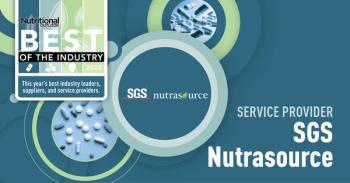
Antiaging nutraceutical ingredients: What’s currently trending?
The list includes nutraceuticals that can positively impact the aging process itself as well as those that positively impact aspects of human physiology that tend to decline with age, such as joint health and cognitive health.
In 2020, the global antiaging market was estimated to be worth about $58.5 billion and projected to see a compound annual growth rate (CAGR) of 7% between 2021 and 2026.1 Dietary supplements and the nutraceuticals they provide are unquestionably a significant part of those sales.
Defining Antiaging Nutraceuticals
The term antiaging can incorporate a broad range of nutraceutical possibilities. For the purpose of this article, let’s define antiaging nutraceuticals as those ingredients that help to address health and wellness issues associated with aging. In this context, that would potentially include nutraceuticals that can positively impact the aging process itself as well as those that positively impact aspects of human physiology that tend to decline with age, such as joint health and cognitive health. Ahead, we touch on a few promising contenders.
Nutraceuticals for the Aging Process
Resveratrol – Resveratrol originally made a big splash in the dietary supplement marketplace due to the fact that intake of it and other polyphenol compounds from red wine may contribute to the “French paradox”—the unexpectedly low rate of death from cardiovascular disease in the Mediterranean population despite a relatively higher intake of saturated fats.2 Then, excitement increased with the understanding that resveratrol helped activate the SIRT 1 gene associated with longevity.3 Since that time, interest in resveratrol has continued to expand due to human research demonstrating its effectiveness for a variety of health benefits, including cognition, mood, inflammation, and immune health. Global resveratrol market revenue was $138 million in 2019 and is projected to reach $228 million in 2025, with a CAGR of 8.57% during 2020-2025.4
NAD promoters – Nicotinamide adenine dinucleotide (NAD+) is an essential cofactor in all living cells that is involved in fundamental biological processes. Mounting evidence indicates that NAD+ levels decline with age in multiple types of tissues. NAD+ depletion has been associated with hallmarks of aging and may underlie a wide range of age-related diseases.5 Restoration of NAD+ levels in older animals can promote health and support lifespan.6 Nutraceuticals commonly used to promote NAD+ levels include nicotinamide riboside (trademarked Niagen) and nicotinamide mononucleotide (NMN). Although not as commonly used for this purpose, niacinamide is also very effective at increasing NAD+ levels.7
Nutraceuticals for Joint Health
The global joint supplements category is poised to reach over $9.4 billion by the year 2025.8 Some of the more interesting and novel joint support nutraceuticals include cucumber extract and Andrographis paniculata extract.
Cucumber fruit extract – Due to its mechanism of reducing TNF-α, a daily dose of only 20 mg—the lowest of any nutraceutical used for treating osteoarthritis—a water extract of cucumber fruit (trademarked Q-Actin) was shown to have greater efficacy than 2,700 mg/day of glucosamine/chondroitin, with a significant improvement in the WOMAC score for physical function, stiffness, and pain of 70.39%, compared to only 33.7% for glucosamine/chondroitin in the same time frame.9
Andrographis paniculata extract – The effect of Andrographis paniculata and its andrographolides on NF-κB and inflammation is impressive. Of even greater significance, however, is the human clinical research demonstrating the ability of an Andrographis paniculata extract providing 50% total andrographolides (trademarked ParActin) to safely and effectively reduce joint inflammation (i.e., swollen joints) and joint tenderness in arthritis sufferers. This nutraceutical allowed arthritis patients to discontinue the use of certain medications with serious side effects.10,11
Nutraceuticals for Cognitive Health
The global brain health (cognitive health) supplements market size was valued at $7.21 billion in 2020 and is expected to expand at a CAGR of 8.0% from 2021 to 2028.12 This supplement category offers a plethora of evidence-based nutraceuticals. From my perspective, two particularly interesting such nutraceuticals include ashwagandha extract and a polyphenol-rich extract from French grape and wild blueberry.
Ashwagandha extract – An ashwagandha extract focusing on specific compounds with nootropic bioactivity (trademarked NooGandha) was given in an acute dose to healthy subjects. The results showed sustained attention and increased short-term/working memory.13 To my knowledge, this was the first time a single dose of ashwagandha was shown to have acute cognitive performance benefits. Other research14 with this same ashwagandha extract demonstrated its effectiveness for improving the physiological, cognitive, and psychological effects of stress.
Polyphenol-rich extract from French grape and wild blueberry – A polyphenol-rich extract from French grape and wild blueberry (trademarked Memophenol) was given to healthy elderly subjects.15 The results showed that supplementation improved verbal episodic and recognition memory (VRM)-free recall. This same extract was also shown to enhance cognitive performance by 36% 90 minutes after supplementation in healthy university students. Evidence suggests that at least one mechanism of action is that the polyphenols modulate cell and molecular processes involved in learning and memory, including neuronal signaling pathways involved in synaptic plasticity (i.e., the brain’s ability to change and adapt as a result of experience).16
Conclusion
The continued growth of the antiaging supplements market shows no sign of declining anytime soon. There is particular interest in nutraceuticals that can positively impact the aging process itself as well as those that positively impact aspects of human physiology that tend to decline with age, such as joint health and cognitive health. These nutraceuticals include resveratrol, NAD+ promoters, cucumber fruit extract, Andrographis paniculata extract, ashwagandha extract, and a polyphenol-rich extract from French grape and wild blueberry.
Gene Bruno, MS, MHS, RH (AHG), possesses 42 years of dietary supplement industry experience. With a master’s degree in nutrition and a second master’s degree in herbal medicine, he has a proven track record of formulating innovative, evidence-based dietary supplements. Mr. Bruno currently serves as both the vice president of scientific and regulatory affairs at
References
- Statista report. “
Value of the Global Antiaging Market 2020-2026. ” Statista. Published January 2021. - Labinskyy N et al. “
Vascular dysfunction in aging: potential effects of resveratrol, an anti-inflammatory phytoestrogen .” Current Medicinal Chemistry, vol. 13, no. 9 (2006): 989-996 - Borra MT et al. “
Mechanism of human SIRT1 activation by resveratrol. ” The Journal of Biological Chemistry, vol. 280, no. 17 (April 29, 2005): 17187-17195 - 360 Market Updates report. “
Global Resveratrol Market Insights: Impact of COVID-19 and Future Expectations to 2025. ” Published June 9, 2021. - Aman Y et al. “
Therapeutic potential of boosting NAD+ in aging and age-related diseases .” Translational Medicine of Aging, vol. 2 (January 2018): 30-37 - Fang EF et al. “
NAD + replenishment improves lifespan and healthspan in ataxia telangiectasia models via mitophagy and DNA repair .” Cell Metabolism, vol. 24, no. 4 (October 11, 2016): 566-581 - Ito TK et al. “
A nonrandomized study of single oral supplementation within the daily tolerable upper level of nicotinamide affects blood nicotinamide and NAD+ levels in healthy subjects .” Translational Medicine of Aging, vol. 4 (2020): 45-54 - Global Industry Analysts report. “
Global Bone and Joint Health Supplements Industry. ” Published April 2021. - Nash RJ et al. “
Effectiveness of Cucumis sativus extract versus glucosamine-chondroitin in the management of moderate osteoarthritis: a randomized controlled trial .” Clinical Interventions in Aging. Published online October 25, 2018. - Burgos RA et al. “
Efficacy of an Andrographis paniculata composition for the relief of rheumatoid arthritis symptoms: A prospective randomized placebo-controlled trial. ” Clinical Rheumatology, vol. 28, no. 8 (August 2009): 931-946 - Hidalgo MA, Hancke JL, Bertoglio JC, Burgos RA. “
Andrographolide a New Potential Drug for the Long Term Treatment of Rheumatoid Arthritis Disease .” In Matsuna H (ed). Innovative Rheumatology. Rijeka, Croatia: InTech; 2013: 247-270 - Grand View Research report. “
Brain Health Supplements Market Size, Share & Trends Analysis Report By Product (Natural Molecules, Herbal Extract), By Application (Memory Enhancement, Depression & Mood), By Region, And Segment Forecasts, 2021 – 2028. Grand View Research .” Published January 2021. - Conference paper. Xing D et al. “
Acute ashwagandha supplementation improves cognitive performance .” JISSN. 2020 17:67 - Remenapp A et al. “Effectiveness of ashwagandha (Withania somnifera) supplementation on adult’s cognition and mood.” Submitted to Journal of Ayurveda and Integrative Medicine as a short communication; 2021
- Bensalem J et al. “
Polyphenols from grape and blueberry improve episodic memory in healthy elderly with lower level of memory performance: A bicentric double-blind, randomized, placebo-controlled clinical study .” The Journals of Gerontology. Series A, Bilological Sciences and Medical Sciences, vol. 74, no. 7 (June 18, 2019): 996-1007 - Spencer JP. “
The interactions of flavonoids within neuronal signalling pathways .” Geners & Nutrition, vol. 2, no. 3 (December 2007): 257-273
Newsletter
From ingredient science to consumer trends, get the intel you need to stay competitive in the nutrition space—subscribe now to Nutritional Outlook.





